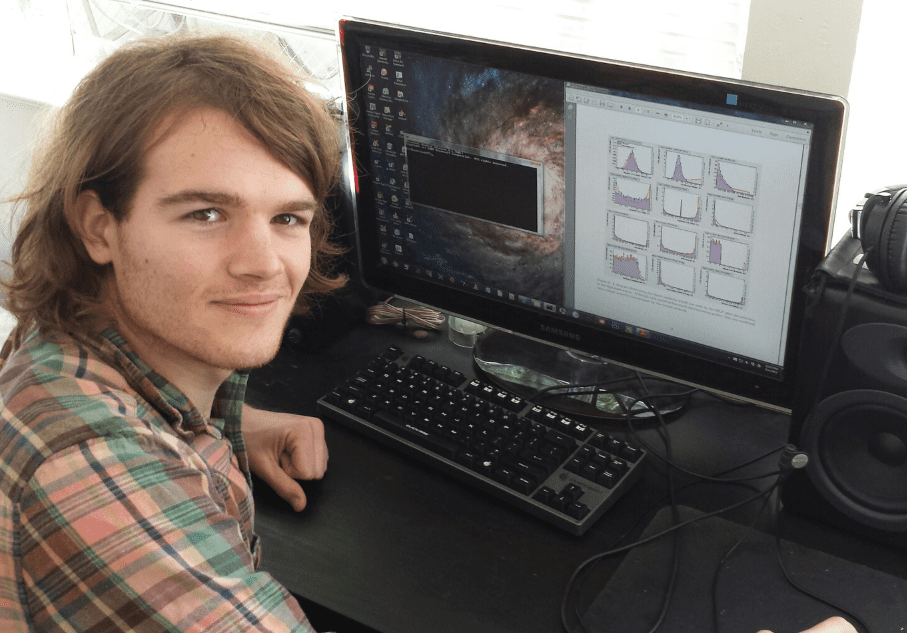Justin Fu

Robots are typically deployed in highly controlled environments, but for robots to become usable in everyday situations, they must be able to learn to adapt to the environment. Reinforcement learning is a popular framework in robotics for teaching robots motor skills in unknown environments through a trial-and-error process. Recently, methods have been developed that allow optimization of high-dimensional control policies, which enables the use of powerful tools from machine learning such as neural networks to decide on which actions the robot should take and when. My project involves using various […]
Alexander Giuffrida

The majority of matter in the universe is dark matter which does not interactwith light. In several physical models dark matter includes a dark photon (A’) which plays a similar role to that of the photon in the normal sector. In addition,recent experiments at CERN have confirmed the existence of the Higgs boson, a particle which mediates the Higgs field that gives other particles mass. Now physicists are proposing theories beyond the Standard Model which introduce additional Higgs states, with one of them (A0), having a lower mass than the […]
Eliel Anttila

A worldwide abundance of glacially deposited sediments in early Neoproterozoic strata suggests the onset of a great global cooling event that began approximately 720 million years ago. Sometimes referred to as the Snowball Earth Hypothesis, this period of massive climactic change resulted in the propagation of glaciers at very low latitudes, and potentially covered the entire surface of the planet with ice. Determining the geographical, climatological, and biological changes that happened prior to the onset of this event can allow us to better understand the processes that led to such […]
Daniel Jeong

Many recent studies have shown that the brains frontal cortex strongly modulates the information processed in the primary sensory cortices. A strong contributor of this modulation, each of the frontal cortical pyramidal neurons can project axons to multiple different brain regions (e.g., thalamus, midbrain, striatum, and other cortical areas) and therefore have fundamentally different roles. However, it is still unknown whether the frontal cortical pyramidal neurons innervating different targets receive inputs from overlapped brain regions or from segregated regions. My research will focus on the cingulate cortex (Cg), the frontal […]
Ruiyao Gong

The Dazu Rock Carving is the only Buddhist cave site in China representing the development of Buddhist teachings during the Song dynasty (960- 1279). My research mainly investigates the Buddhist statues of Dazu site, with a special focus on Mahamayuri Vidyaraja, or the Great Peacock King at Baodingshan, Dazu. The Great Peacock King, a deity who can cure all evils in Esoteric Buddhism and who always rides on a peacock, is rarely depicted in other Buddhist caves. Dazu has three statues of him, however, at Baodingshan, Northern Mountain and Shimen […]
Renan Aparicio

The prevalence of neurodegenerative diseases has reached an unprecedented level and is now a prominent threat to the health and wellbeing of our aging population. As a result, the demand for effective therapies has become of paramount importance. Studying proteins involved in neurodegeneration allows researchers to outline cellular pathways leading to disease, which in turn helps provide targets for drug molecules. Recently, scientists discovered a link between different neurodegenerative diseases and specific point mutations in triggering receptor expressed on myeloid cells 2 (TREM2). TREM2 is normally expressed at the cell […]
Dipin Kaur

While it is the largest democracy in the world, Indias human rights record with respect to conflict zones has been unsteady at best. In many areas of the country with past and ongoing conflicts, the commission of human rights violations of the government has been continuous and widespread. The failure of the Indian state to investigate these human rights abuses committed by its own departments has created a structure where, in these areas of conflict, basic human rights have been suspended and faith in the democratic system, the police and […]
Apurva Govande

A virus can have two distinct life cycles: lytic, which produces new virus, and latent, in which the virus remains silently integrated into the DNA of the host. The ultimate goal of a latent virus like Kaposis sarcoma-associated herpesvirus (KSHV) is to get its viral genes integrated into the host genome, and eventually produce viral proteins in order to generate more virus. These viral proteins interact with the host cell organelles and proteins in order to hijack host machinery for viral use. A KSHV viral protein, ORF68, interacts with and […]
Lawrence Bai

Found in many species of bacteria and archaea, the clustered regularly interspaced short palindromic repeats (CRISPR) and CRISPR associated (Cas) proteins provide an adaptive defense mechanism against foreign invaders such as viruses and plasmids. By integrating segments of the foreign DNA into the CRISPR locus of the host genome, the bacteria remember the invaders and can subsequently produce CRISPR RNAs (crRNAs) to destroy the foreign DNA complementary to the crRNA. In particular, Cas9 plays a major role in using the short RNA as a guide to search for any DNA […]
Zhengzheng Hu
The Game of Chomp (also called Northeast) is a two-player game on a rectangular chocolate bar consisting of m-by-n squares. Players take turns eating chocolate squares on the board. If a player eats a square, they must eat all squares lying above (north) and to the right (east) of that piece. Whichever player eats the lowest left corner chocolate square (poisoned) loses (Gale). For my project, I am trying to apply Sprague-Grundy value from Game Theory and Young diagrams from Algebra to characterize winning strategies for Chomp or provide evidence […]